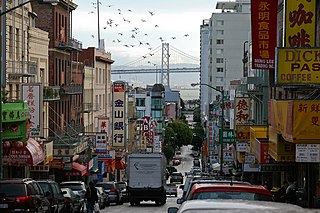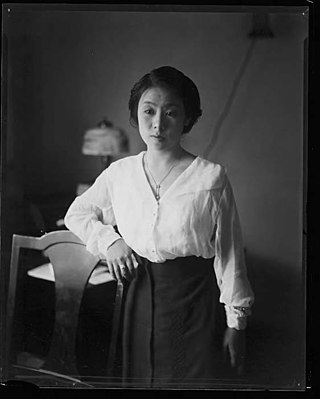
Chinatown is the catch-all name for an ethnic enclave of Chinese people located outside Greater China, most often in an urban setting. Areas known as "Chinatown" exist throughout the world, including Europe, Asia, Africa, Oceania, and the Americas.

The Chinatown centered on Grant Avenue and Stockton Street in San Francisco, California, is the oldest Chinatown in North America and one of the largest Chinese enclaves outside Asia. It is also the oldest and largest of the four notable Chinese enclaves within San Francisco. Since its establishment in the early 1850s, it has been important and influential in the history and culture of ethnic Chinese immigrants in North America. Chinatown is an enclave that has retained its own customs, languages, places of worship, social clubs, and identity.

Chinatown is a neighborhood in Downtown Los Angeles, California, that became a commercial center for Chinese and other Asian businesses in Central Los Angeles in 1938. The area includes restaurants, shops, and art galleries, but also has a residential neighborhood with a low-income, aging population of about 7,800 residents.

In non-Asian countries, an Asian supermarket largely describes a category of grocery stores that focuses and stocks items and products imported from countries located in the Far East.

Philip Ahn was an American actor and activist of Korean descent. With over 180 film and television credits between 1935 and 1978, he was one of the most recognizable and prolific Asian-American character actors of his time. He is widely regarded as the first Korean American film actor in Hollywood. He is not to be confused with Philson Ahn, another screen actor who broke into films in the late 1930s; Philson was Philip's younger brother.

The Chinatown neighborhood in Oakland, California, is traditionally Chinese which reflects Oakland's diverse Chinese American, and more broadly Asian American community. It is frequently referred to as "Oakland Chinatown" in order to distinguish it from nearby San Francisco's Chinatown. It lies at an elevation of 39 feet.

The Asian-American influx to the San Gabriel Valley grew rapidly when Chinese began settling in Monterey Park, California, in the western San Gabriel Valley in the 1970s. Just east of Los Angeles, the region has achieved international prominence as a hub of overseas Chinese, or hua qiao. Although Chinese immigrants were a noteworthy presence in the establishment of Southern California from the 19th century, significant Chinese migration to suburban San Gabriel Valley coincided with a trend of white out-migration from the 1970s onward. This opened an opportunity for middle-class Asian Americans to begin settling in the San Gabriel Valley.

Wah Ching is a Chinese American criminal organization and street gang that was founded in San Francisco, California in 1964. The Wah Ching has been involved in crimes including narcotic sales, racketeering, and gambling.

AsianWeek was America's first and largest English-language print and on-line publication serving East Asian Americans. The news organization played an important role nationally and in the San Francisco Bay Area as the “Voice of Asian America”. It provided news coverage across all East Asian ethnicities.

Soon-tek Oh was a Korean–American actor. He was the voice of Fa Zhou in Disney's Mulan and the direct-to-video sequel Mulan II and the sadistic Colonel Yin in Missing in Action 2: The Beginning. He has starred in many films, and also acted in television series, including Stargate SG-1; MacGyver; M*A*S*H; Charlie's Angels; Airwolf, Magnum, P.I.; Hawaii Five-O; Kung-Fu; Zorro; The Man with the Golden Gun; Baa Baa Black Sheep and Touched by an Angel.

Yellow is an American 1997 comedy drama film directed by Chris Chan Lee. The film follows eight Korean–American youths in Los Angeles over the course of a wild night before their high school graduation. The film stars an ensemble cast including Michael Chung, John Cho, Burt Bulos, Jason Tobin, and Lela Lee. The film had its world premiere at the 15th CAAMFest in San Francisco in 1997.

Forbidden City was a Chinese nightclub and cabaret in San Francisco, which was in business from 1938 to 1970, and operated on the second floor of 363 Sutter Street, between Chinatown and Union Square.

Asian American history is the history of ethnic and racial groups in the United States who are of Asian descent. The term "Asian American" was an idea invented in the 1960s to bring together Chinese, Japanese, and Filipino Americans for strategic political purposes. Soon other groups of Asian origin, such as Korean, Indian, and Vietnamese Americans were added. For example, while many Chinese, Japanese, and Filipino immigrants arrived as unskilled workers in significant numbers from 1850 to 1905 and largely settled in Hawaii and California, many Vietnamese, Cambodian, and Hmong Americans arrived in the United States as refugees following the Vietnam War. These separate histories have often been overlooked in conventional frameworks of Asian American history.
Him Mark Lai was a historian of Chinese American, a leader of the Chinese-American community, and writer. He helped restore the state of Chinese American historiography. Lai "rescued, collected, catalogued, preserved and shared" historical sources in Chinese and English. He was known as the "Dean of Chinese American history" by his academic peers, despite the fact that he was professionally trained as a mechanical engineer with no advanced training in the academic field of history. The Chronicle of Higher Education named Lai "the scholar who legitimized the study of Chinese America".

Chinatowns are enclaves of Chinese people outside of China. The first Chinatown in the United States was San Francisco's Chinatown in 1848, and many other Chinatowns were established in the 19th century by the Chinese diaspora on the West Coast. By 1875, Chinatowns had emerged in eastern cities such as New York City, Boston, and Philadelphia. The Chinese Exclusion Act of 1882 barred Chinese immigration to the United States, but the Magnuson Act of 1943 repealed it, and the population of Chinatowns began to rise again.
Asian Californians are residents of the state of California who are of Asian ancestry. California has the largest Asian American population in the U.S., and second highest proportion of Asian American residents, after Hawaii. As of the 2020 U.S. Census, there were over 6 million Asian-Americans in California; 15.5% of the state's population. If including those with partial Asian ancestry, this figure is around 17%. This is a jump from 13.8% recorded in 2010.
As of 2012, 21.4% of the population in San Francisco was of Chinese descent, and there were at least 150,000 Chinese American residents. The Chinese are the largest Asian American subgroup in San Francisco. San Francisco has the highest percentage of residents of Chinese descent of any major U.S. city, and the second largest Chinese American population, after New York City. The San Francisco Area is 7.9% Chinese American, with many residents in Oakland and Santa Clara County. San Francisco's Chinese community has ancestry mainly from Guangdong province, China and Hong Kong, although there is a sizable population of ethnic Chinese with ancestry from other parts of mainland China and Taiwan as well.
Asians in New York City represent the largest Asian diaspora of any city in the world.
This is a timeline of notable events in the history of non-heterosexual conforming people of Asian and Pacific Islander ancestry, who may identify as LGBTIQGNC, men who have sex with men, or related culturally-specific identities. This timeline includes events both in Asia and the Pacific Islands and in the global Asian and Pacific Islander diaspora, as the histories are very deeply linked. Please note: this is a very incomplete timeline, notably lacking LGBTQ-specific items from the 1800s to 1970s, and should not be used as a research resource until additional material is added.
Sexuality, including same-sex sexuality, and other non-normative forms of sexuality have been central to the history of Chinatown, San Francisco. San Francisco's Chinatown, founded in 1848, is the first and largest in the United States. San Francisco was shaped by early Chinese immigrants, who came from the Guangdong province of southern China. These immigrants gathered in the Bay Area in order to join in the California Gold Rush and to build railroads in the American west. San Francisco's Chinatown made room for these early Chinese immigrants to live, and the area turned into a "bachelor society", where female prostitution was pervasive because of the Chinese Exclusion Act. As a racialized immigration region, Chinatown was viewed as an immoral place with the characteristics of "vice", "sluttery" and "sexual deviance" for a long time. These traits were incompatible with the mainstream culture and dominant norms of American society. From the mid-19th century, the state problematized Chinese female prostitution with the subject of sexual transmission, and the government began to go against industrial prostitution in Chinatown, as well as Chinese immigration. As the sex industry grew throughout the Bay Area, the government had to stop the anti-prostitution and anti-immigration law in the beginning of the 20th century. Just like the Castro district and other areas, Chinatown developed its own sexual industries and provided a variety of sexual entertainment to both immigrants and white visitors.